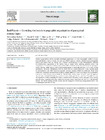BackWards — Unveiling the brain's topographic organization of paraspinal sensory input
dc.contributor.author
Guekos, Alexandros
dc.contributor.author
Cole, David M.
dc.contributor.author
Dörig, Monika
dc.contributor.author
Stämpfli, Philipp
dc.contributor.author
Schibli, Louis
dc.contributor.author
Schuetz, Philipp
dc.contributor.author
Schweinhardt, Petra
dc.contributor.author
Meier, Michael Lukas
dc.date.accessioned
2023-11-10T15:55:59Z
dc.date.available
2023-11-10T04:41:04Z
dc.date.available
2023-11-10T15:55:59Z
dc.date.issued
2023-12-01
dc.identifier.issn
1053-8119
dc.identifier.issn
1095-9572
dc.identifier.other
10.1016/j.neuroimage.2023.120431
en_US
dc.identifier.uri
http://hdl.handle.net/20.500.11850/641231
dc.identifier.doi
10.3929/ethz-b-000641231
dc.description.abstract
Cortical reorganization and its potential pathological significance are being increasingly studied in musculoskeletal disorders such as chronic low back pain (CLBP) patients. However, detailed sensory-topographic maps of the human back are lacking, and a baseline characterization of such representations, reflecting the somatosensory organization of the healthy back, is needed before exploring potential sensory map reorganization. To this end, a novel pneumatic vibrotactile stimulation method was used to stimulate paraspinal sensory afferents, while studying their cortical representations in unprecedented detail. In 41 young healthy participants, vibrotactile stimulations at 20 Hz and 80 Hz were applied bilaterally at nine locations along the thoracolumbar axis while functional magnetic resonance imaging (fMRI) was performed. Model-based whole-brain searchlight representational similarity analysis (RSA) was used to investigate the organizational structure of brain activity patterns evoked by thoracolumbar sensory inputs. A model based on segmental distances best explained the similarity structure of brain activity patterns that were located in different areas of sensorimotor cortices, including the primary somatosensory and motor cortices and parts of the superior parietal cortex, suggesting that these brain areas process sensory input from the back in a “dermatomal” manner. The current findings provide a sound basis for testing the “cortical map reorganization theory” and its pathological relevance in CLBP.
en_US
dc.format
application/pdf
en_US
dc.language.iso
en
en_US
dc.publisher
Academic Press
en_US
dc.rights.uri
http://creativecommons.org/licenses/by/4.0/
dc.subject
Cortical maps
en_US
dc.subject
Representational similarity analysis
en_US
dc.subject
Chronic low back pain
en_US
dc.title
BackWards — Unveiling the brain's topographic organization of paraspinal sensory input
en_US
dc.type
Journal Article
dc.rights.license
Creative Commons Attribution 4.0 International
dc.date.published
2023-10-30
ethz.journal.title
NeuroImage
ethz.journal.volume
283
en_US
ethz.journal.abbreviated
NeuroImage
ethz.pages.start
120431
en_US
ethz.size
9 p.
en_US
ethz.version.deposit
publishedVersion
en_US
ethz.identifier.wos
ethz.identifier.scopus
ethz.publication.status
published
en_US
ethz.date.deposited
2023-11-10T04:41:04Z
ethz.source
SCOPUS
ethz.eth
yes
en_US
ethz.availability
Open access
en_US
ethz.rosetta.installDate
2023-11-10T15:56:00Z
ethz.rosetta.lastUpdated
2024-02-03T06:24:41Z
ethz.rosetta.versionExported
true
ethz.COinS
ctx_ver=Z39.88-2004&rft_val_fmt=info:ofi/fmt:kev:mtx:journal&rft.atitle=BackWards%20%E2%80%94%20Unveiling%20the%20brain's%20topographic%20organization%20of%20paraspinal%20sensory%20input&rft.jtitle=NeuroImage&rft.date=2023-12-01&rft.volume=283&rft.spage=120431&rft.issn=1053-8119&1095-9572&rft.au=Guekos,%20Alexandros&Cole,%20David%20M.&D%C3%B6rig,%20Monika&St%C3%A4mpfli,%20Philipp&Schibli,%20Louis&rft.genre=article&rft_id=info:doi/10.1016/j.neuroimage.2023.120431&
Files in this item
Publication type
-
Journal Article [128982]

